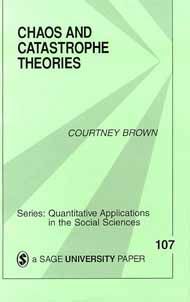Chaos and Catastrophe (original) (raw)
Published in 1995 by Sage Publications (Thousand Oaks, CA) as Volume 107 in the Quantitative Applications in the Social Sciences series.
Click on image to link
to Amazon.com.
"SEARCH INSIDE" available!
From the publisher's description of the book:
Chaos and catastrophe theories have become one of the major frontiers in the social sciences. Brown helps to clarify this complex new technique for modeling by approaching it with the following questions: What is Chaos? How can it be measured? How are the models estimated? What is catastrophe? How is it modeled? Beginning with an explanation of the differences between deterministic and probabilistic models, Brown introduces the reader to chaotic dynamics. Other topics covered are finding settings in which chaos can be measured, estimating chaos using nonlinear least squares, and specifying catastrophe models. Finally, the author estimates a nonlinear system of equations that models catastrophe using real survey data. Researchers wanting to understand and make use of this exciting new direction in social measurement and modeling will find this book an excellent and cogent introduction.
Table of Contents
- Working with Deterministic Mathematical Models
 The Argument in Favor of the Deterministic Approach
The Argument in Favor of the Deterministic Approach - What is Chaos?
 Necessary Conditions for Chaos
Necessary Conditions for Chaos Characteristics of Chaos
Characteristics of Chaos - Measuring Chaos
 Lyapunov Characteristic Exponents
Lyapunov Characteristic Exponents Fourier Analysis
Fourier Analysis Phase Space Reconstruction of an Attractor Using Data
Phase Space Reconstruction of an Attractor Using Data The Spatial Correlation Test
The Spatial Correlation Test - Estimating Chaos Models
 The Problem of Step Size
The Problem of Step Size Comparing the Model's Predicted Values to the Data
Comparing the Model's Predicted Values to the Data The Future of Chaotic Studies in the Social Sciences
The Future of Chaotic Studies in the Social Sciences An Alternative Approach for Maps
An Alternative Approach for Maps - What is Catastrophe?
 Placing the Cusp in the Range of the Data
Placing the Cusp in the Range of the Data - Strategies for Specifying Catastrophe Models
- Estimating Catastrophe Models
References
